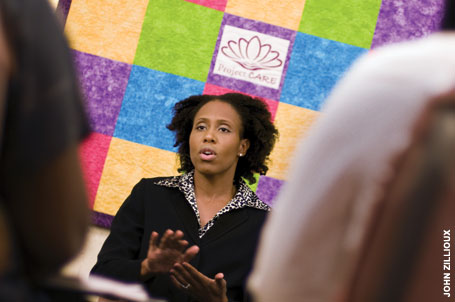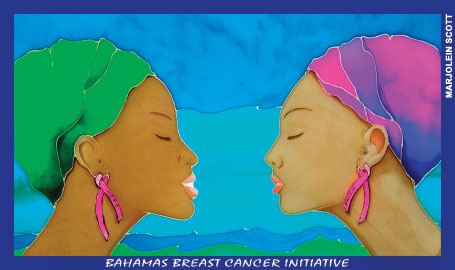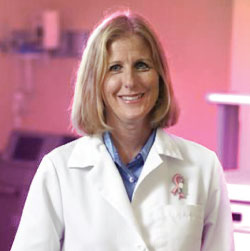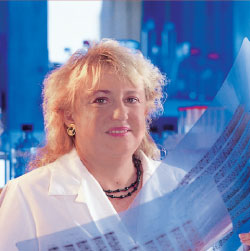Targeting Deadly Disparities
By Lisa Worley
From the islands of the Bahamas
to inner-city Miami, UHealth physicians and Miller School scientists are pursuing the genetic factors behind aggressive breast cancers among women of African descent and working to broaden access to evidence-based care, support, and follow-up.
 |
| Nicole Ennis Whitehead, Ph.D., manager of the Biopsychosocial Oncology Shared Resource at Sylvester Comprehensive Cancer Center and a co-founder of Project CARE, says the project was designed to “raise awareness in the local community about the unique issues facing black women with breast cancer.” |
With their abundant sunshine, sparkling waters, and sandy beaches, the Bahamas attract millions of visitors each year. But the islands’ natural beauty and lively tourist trade hide a sinister statistic: They are also home to the highest incidence of inherited breast cancer in the world.
Nearly 45 percent of Bahamian women who are diagnosed with breast cancer already are at the late stage, compared to only about 12 percent of female breast cancer patients in the United States. That stark statistic was long hidden from high-level cancer researchers and might have remained so, were it not for Miller School associate professor of medicine Judith Hurley, M.D.
About ten years ago, Hurley noticed a pattern at Jackson Memorial Hospital: Scores of Bahamian women—mothers and daughters, sisters and aunts—were presenting with aggressive forms of breast cancer at alarmingly young ages. No one knew why. So Hurley, a medical oncologist with the Braman Family Breast Cancer Institute at Sylvester Comprehensive Cancer Center, part of the UHealth – University of Miami Health System, embarked on a decade-long search for answers.
Armed with a grant from the Avon Foundation, Hurley examined the charts of 100 breast cancer patients in Nassau and found that 52 percent were younger than 50 at the time of diagnosis. In the United States, the average age is 62. “Something was definitely wrong,” says Hurley.
Hurley hypothesized that mutations in the breast cancer gene passed through many generations and caused an increase in breast cancer in young women. Supported by the Komen Foundation, the Bahamas Breast Cancer Initiative, and the Ride for Hope, Hurley and her team arrived at a startling finding: 23 percent of Bahamian women had mutations of the BRCA1 breast cancer gene, putting them at a higher risk for the disease.
In the U.S., inherited breast cancer makes up about 3 to 5 percent of breast cancer cases. Until now the world’s highest reported rate of these cases was in women of Ashkenazi Jewish descent: Eleven percent of those with breast cancer have alterations in the BRCA1 or BRCA2 gene.
 |
| The Bahamas Breast Cancer Initiative is partnering with the Miller School’s Judith Hurley, M.D., and her team to raise awareness and improve
detection of aggressive breast cancers that disproportionately affect Bahamian women. |
“Any woman with breast or ovarian cancer in the Bahamas should be tested for BRCA1 mutations,” says Hurley, who travels to the islands monthly for her work. “It changes what you would do to protect yourself.”
Lynn Cleare-Adderley and her sister Gale Cleare, both breast cancer survivors who tested positive for the BRCA1 mutation, know the disease can kill; their sister Jean died from breast cancer at age 31. Cleare-Adderley says the work of Hurley and her team has made her “realize I do not have to have cancer. They’ve given me a choice.” The two surviving sisters are raising money to have their breasts and ovaries removed to reduce their risk of a recurrence.
A bilateral mastectomy reduces a woman’s risk up to 90 percent. Women who choose to have their ovaries out after completing their families not only remove the risk of ovarian cancer but decrease their risk of breast cancer by 50 percent. Taking tamoxifen for five years can drop the risk by 30 percent. Highly intensive screening could detect the cancer early—at a curable stage 1 instead of an incurable stage 4.
“We need to find out how common this gene is,” says Hurley. “If it’s common, maybe these women need more aggressive screening.”
Hurley and her team are working with the Bahamas Breast Cancer Initiative Foundation to develop a more specific screening test; they hope to soon begin a study pairing genetic testing with screening mammograms. If the team determines that the gene is common in the population, Bahamian women would be treated as a high-risk population and screening would start much earlier than is recommended by the American Cancer Society. The Cancer Society of the Bahamas is working to educate women on the issue. Hurley has applied for a grant from the Komen Foundation to test women in other Caribbean nations, where she suspects there are similar mutations.
 |
| Judith Hurley, M.D. |
Triple-negative breast cancer, one of the most aggressive forms of the disease, also is over-expressed in African-American women. Because this type of malignancy is negative for the expression of estrogen, progesterone receptors (ER/PR), and the HER2 protein, triple-negative patients will not respond to hormonal therapy.
Lisa Baumbach, Ph.D., associate professor of neurology, is rising to the challenge of aggressive breast cancers. Among her studies is a Department of Defense-funded grant with Mark Pegram, M.D., professor of medicine and associate director of clinical research at Sylvester. In collaboration with international researchers, the two are examining gene expression of breast cancer in African women and African-American patients to learn why African-American women have a more aggressive form of the disease and a higher death rate—and to identify better prevention and treatment strategies.
 |
| Lisa Baumbach, Ph.D. |
Baumbach and Pegram are also collaborating with Hurley on a National Cancer Institute Challenge Grant-funded study that examines breast tissue from Hurley’s patients at Jackson Memorial Hospital. The goal is to develop a profile of molecular markers that more accurately predict the effectiveness of a current treatment so that doctors don’t waste valuable time on a therapy that will ultimately be unsuccessful.
In another cutting-edge study, this one funded by a State of Florida Bankhead-Coley Grant, Baumbach is comparing genes expressed in normal breast tissue of Caucasian women to normal tissue in African-Americans. “We may find that African-American women have a genetic predisposition to more aggressive breast cancer,” Baumbach notes, “which would provide groundbreaking insights into new models for disease prediction and prevention.”
Unfortunately, many African-American women do not get diagnosed until their breast cancer is advanced; similarly to Bahamian women, they are developing breast cancer at a much younger age than women of other ethnic backgrounds.
“Where does the system fail? Is it the screening or the treatment?” asks Leonidas Koniaris, M.D., associate professor of surgery and member of Sylvester. A $1.2 million state grant is enabling him to pursue the answers.
A recent Koniaris study found that a quarter of African-American patients were being diagnosed with breast cancer before age 45. Over the next five years, he’ll be working with community experts to reach these women much sooner. Studies indicate little difference between outcomes for Caucasians and African-Americans with stage 1 or 2 breast cancer. But, Koniaris says, “When you get to metastatic breast cancer, it’s staggering.”
In a 2008 study, Koniaris and Hurley established that academic medical centers and their teaching hospitals often offer multiple therapies and clinical trials not available anywhere else, providing stage 4 breast cancer patients with a significant survival advantage. In a study published the following year in the Journal of the American College of Surgeons, Koniaris recommended that initial mammogram screening for African-Americans begin at age 33 rather than 40. “To fix the disparities,” he notes, “we need to fix the screening and then the treatment.”
Once diagnosed and treated, many African-American breast cancer patients face an uphill battle. More than white and Hispanic women, they tend to be underserved in counseling and follow-up care—leaving many, says Suzanne Lechner, Ph.D., “wondering ‘where do I go from here?’”
In spring 2009, Lechner, research assistant professor of psychiatry and behavioral sciences, launched Project CARE (Cope, Adapt, Renew, Empower) to help women after breast cancer treatment.
Funded by the National Institutes of Health, the five-year initiative gathers survivors for ten weeks of group sessions; the research team follows up with each participant after six months. Lechner hopes to get funding for an additional five-year follow up and, more important, to keep the program running beyond the study.
Many of these women, Lechner explains, have not been told about the need for intensive follow-up or taught the benefits of exercise, improved nutrition, and stress management in fending off a recurrence. Women are often dealing with real-world issues such as paying rent, arranging transportation, and “doing what needs to be done,” says Lechner. “That’s where we pick them up.”
A Project CARE radio announcement caught the ear of Sylvia Wromas. Nearly one year earlier, she had undergone a lumpectomy and endured seven months of recurrent hospital stays because of severe side effects from her chemotherapy regimen.
Wromas, a pre-kindergarten teaching assistant, says the group sessions were “very beneficial and supportive.” She was especially appreciative that participants were given practical help, such as how to obtain assistance with cleaning their homes.
Though she hasn’t fully recovered from her experiences, Wromas says she felt a welcome connection at Project CARE, which helped her realize that “I wasn’t the only one to feel this way.”
Lisa Worley is director of media relations at the Miller School of Medicine. |


